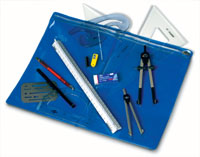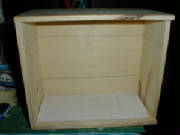|

Before you start building:
- Decide what elements your scene will include. This is the easy part -- time to dream, plan, draw sketches,
etc. The hard part comes when you have to figure out how to bring the world you imagine into existence!
- Determine what the measurements of your box will be. Make sure that it can accomodate all the elements
in your scene.
- Draw some sketches of your scene, (or make some templates of your elements) just to get an idea of how
they will look/fit inside the box.
- Measure carefully to minimize mistakes and waste.
- Gather all the tools and materials you will need so once you start working you don't need to go searching
for them. It will save time ... and aggravation. ;-)
- Make sure that your tools are sharp and ready. Have sharpened pencils and replacement blades handy.
- If you are using power tools, make sure to wear eye protection and a dust
mask (the sawdust of some woods --such as walnut-- is toxic)!.
- Have your favorite music playing in the background, for inspiration.
- Have plenty of wet wipes (or wet towel) handy, too, you will be glad you did!
- Keep your sense of humor accessible -- you are bound to need it some time or another.
- Don't forget to have fun!

Materials for the Box:
- Wood or construction board (see below)
- Craft tissue paper (preferably white, to simulate stucco)
- White glue (I prefer Weldbond, but any tacky glue will do)
- Acrylic paints
- Variation: cover box with fabric or decorative paper (or
stain wood)
Tools:
- Craft knife or saw
- Sanding paper
- Pencil
- Ruler (preferably metal, cork-backed to prevent slips)
- Scissors
- Foam brush (for applying main color)
- Fan brush (for applying highlights)
Measurements:
I used a purchased wooden box with interior measures of:
- 8" wide x 7" high x 3 1/2" deep
- = (equivalent in 1:48 scale) 32 feet wide x 28 feet high x 14
feet deep
The wood is 1/8" thick, (4 mm) which is quite thick for 1:48 scale, but since the box is
merely the container housing the scene (not the walls of a dollhouse) the thickness is not that relevant.
Substitutes for wood:
You can build your box out of...
- mat board, illustration board, foam core board, or mdf.
Note: I used illustration board for the walls and floor of the courtyard itself.
I find that it is quite strong, easy to cut, and if you glue two sheets together you will end up with extremely sturdy walls
for your roombox. I always like to glue the illustration board floor to a wood subfloor, both for strength and to make
it easy to build and finish the courtyard independently (and slide it in and out of the box easily).
About size: The size of your box will be determined by the scale you are working in,
and how many elements you wish to include in your scene (fountains, potted/not potted plants, trees, steps/stairs, etc.
Just calculate the square footage it would take in real life to accomodate those elements, and then build a box
that is the equivalent of those measurements.
I have included the equivalent measures of what they represent in 1:48 scale to make it easier for you
to adapt both the shape and measurements of your own box according to the design and the scale you are using for
your version.
About shape: My box is shallow (overall depth is 4" but 1/2" accomodates the slide-in
plexiglass cover). You could easily build a square, angled, arched, or rectangular box with lots more width
and depth, which will give you more space for decorating and landscaping. You could also eliminate the top of the
box, and/or one of the sides. There are so many ways in which you could depict your courtyard -- have fun!
|

